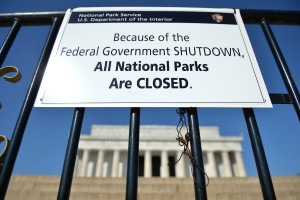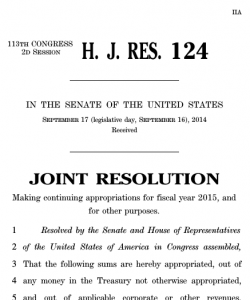The President thought government spending was out of control, so he vetoed the appropriations bill. Congress was determined and over-rode the veto, restoring funding despite his objections. But it took 10 days for full funding to be restored, and in the meantime, two federal departments were shut down.
That may sound like a common theme today, but the year was 1976 and the President was Gerald Ford. I was an intern on the House side that semester, the first that Mesa College had ever sent to Capitol Hill, and it seemed like historically wild times. A government shutdown had never happened before. Little did we all know how common it would become in the years ahead.
 There were 5 similar shutdowns during the Carter Administration and 9 during the Reagan-Bush years, but Congress always backed down in time to restart the government by Monday morning. That changed in the 1990s when President Clinton called the bluff and allowed the entire government to shut down for almost a month over budget disputes – and House Republicans largely took the blame in public opinion.
There were 5 similar shutdowns during the Carter Administration and 9 during the Reagan-Bush years, but Congress always backed down in time to restart the government by Monday morning. That changed in the 1990s when President Clinton called the bluff and allowed the entire government to shut down for almost a month over budget disputes – and House Republicans largely took the blame in public opinion.
Another two-week shutdown over Obamacare in 2013 is the latest example, and the ongoing prospect has become a political third rail. That’s because a shutdown does far more than call attention to a particular dispute (such as the current crisis over funding Planned Parenthood). It also sends workers home, closes parks, holds up people’s checks, and possible endangers our security. No one wants the blame for that.
Today almost any major action in Congress to rein in what it views as abuses of the executive branch – especially regulatory over-reach by the EPA, IRS, NSA and others – draws the threat of a presidential veto and a resulting government shutdown. Leaders in both Houses re-assure everyone that it won’t happen, and their critics (some of whom like the idea of an extended vacation for the government) accuse them of unilateral disarmament – taking the “nuclear option” off the table.
In fact, there is no reason for this ever to happen again. Under the Constitution, Congress has ultimate control of the purse-strings, but also the structure of the appropriations process itself. Believe it or not, the easy solution is to make that process more complicated.
Since the 1920s Congress has organized the spending process parallel to the structure of the executive branch, with separate appropriation bills for different departments and groups. In the modern era that means there are 12 huge spending bills to be passed every year. There are major disputes on all of them, and in the past decade Congress has passed almost none of them, instead lumping everything into a single gargantuan “continuing resolution” – continuing everything at current levels until more detailed bills can be passed. That continuing resolution (CR) becomes a Christmas tree on which all manner of amendments are hung, adding to the ridiculousness of the process, and resulting in bills so thick that nobody can possibly read them.

Lots of people get angry that big debates over major amendments always seem to be on the CR, often threatening a possible government shutdown if an agreement cannot be reached. But in the mostly-dysfunctional Congress of recent times, Members have to put such amendments on the CR, because it is the only bill they know must pass. That system actually deprives Members of Congress, and the people they represent, of any meaningful power over the operation of government. Congress created the mess, and can fix it.
Here is the simple solution – break the 12 annual spending bills into 100. There are 15 cabinet departments and about 75 independent agencies. A separate bill for each one would bring the size and scope of federal power and money into sharp focus.
If Congress wanted to stop funding the Legal Services Corporation, public broadcasting, Amtrak, or any number of others that candidates often claim they would abolish, it could simply fail to pass that particular bill. Doing so would cause nothing else to shut down.
If Congress wanted to rein in the EPA, it could easily fund the agency – omitting funding for the new “waters of the US” regulation, or the proposed “clean power plan” that would all but ban coal, or projects like that which poisoned the Animas River last month. That way, if the President wanted to veto the bill over such issues, he would not be shutting down the entire government, just the EPA. Many Americans might be OK with that.
(A version of this column originally appeared in the Grand Junction Daily Sentinel September 4, 2015)




Comments on this entry are closed.